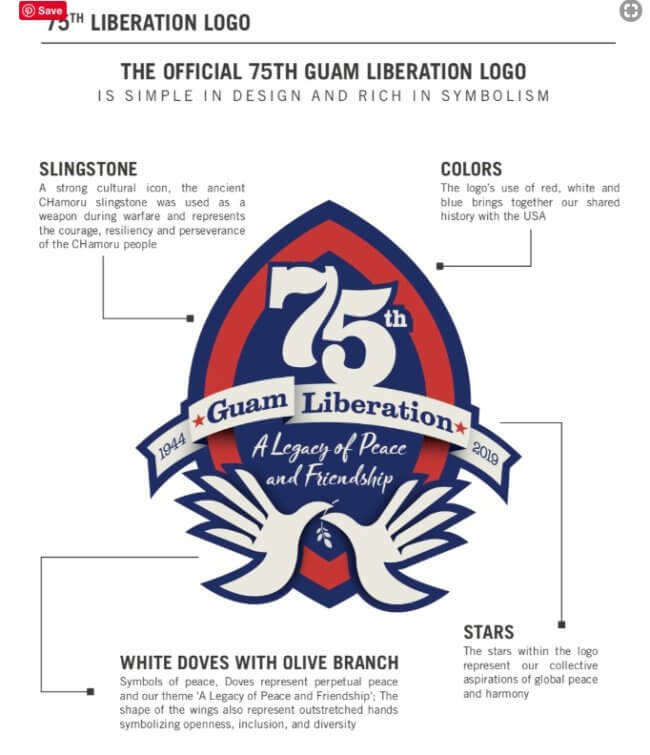Where can you find a piece of American history and ancient culture like no other place else? Where can you find a piece of America so remote and so authentic and so beautiful, that it takes you 7- 20 hours to get there? The answer is Guam, where America’s day begins.
Guam’s biggest celebration ever already started. If there was ever a good time to travel to Guam it is this year.
A legacy of peace and friendship for 75 years is leading to Liberation day in Guam is on Sunday, July 21with nonstop events and partying until the closing on August 11, 2019.
Kicked off by Governor Ricardo J. Bordallo Governor with Guam Flag Day on May 12 the 31st Guam Micronesia Island Fair is coming up this Wednesday at Plaza de España Hågatña, Guam It will really get crazy on June 6 on Guam’s Carnival Grounds Hågatña.
After World War II was over community leader Agueda Iglesias Johnston convinced US military leaders on Guam to support a celebration to commemorate the Liberation of the island from the Japanese. This celebration continues to this day as one of Guam’s holidays – Liberation Day, which is celebrated on July 21st.
While there were Liberation Day commemorations in the late 1940s and then Liberation Day celebrations in the early 1950s, the first Liberation Day queen contest wasn’t held until 1948. Beatrice Blas Calvo Perez was the first Liberation Day Queen of Guam. The winner was declared based on ticket sales, just as it is today.
The 75th Guam Liberation Committee held its first press conference on April 17. Following a short introduction by Mayor Melissa Savares of Dededo, Governor Lou Leon Guerrero discussed the significance behind the theme of “A Legacy of Peace and Friendship.”
“The concept of peace and friendship is ingrained in our culture,” says Leon Guerrero. “In times of conflict, it means we work together in the spirit of inafa’maolek – working in harmony for the common good. During this milestone year, let us celebrate our diversity, acceptance, and global peace and unity.”, he said.
White-sand beaches with crystal-clear waters, lush mountains streaked with tumbling waterfalls, and some of the most spectacular sunsets in the world lure scores of sun-soaking travelers every year. Along Tumon Bay, a waterfront hotspot, luxury resorts, and duty-free shopping malls complete the picture-perfect, remote-island-paradise vacation.
But there’s more to this island than meets the eye.
The westernmost territory of the United States, Guam lies at the bottom of Micronesia’s Mariana Islands archipelago. The island has been under U.S. rule since 1898, after two centuries of Spanish colonization, and is perhaps best known to Americans for its value as a strategic military outpost in the Pacific; it’s home to a large U.S. military presence, including Andersen Air Force Base.
What is less known, however, is the incredibly rich history and culture beneath Guam’s surface. They stretch back 4,000 years and continue to live on—waiting to be discovered on the island today.
Millennia-Old Culture
Long before Guam became host to military forces and tourists, the Chamorro people made it their home.
These ancient seafarers, likely from Southeast Asia, were settling the Mariana Islands as early as 2,000 B.C., navigating the waters by the stars in their nimble “flying proa” canoes. These first inhabitants of the island laid the foundations for Guam’s millennia-old indigenous culture.
Perhaps the most striking physical remnants of this ancient culture are the megalithic latte (pronounced LAH-tee), stone pillars topped with cup-shaped capstones, still standing throughout Guam and the rest of the Marianas. These unique structures, found nowhere else in the world, were built as the bases of ancient Chamorro houses. Walking among them transports you to a past civilization.
possible to reach millions worldwide
Google News, Bing News, Yahoo News, 200+ publications
Over the course of its complex history, Guam’s culture was layered with influences from Spain, the United States, and Japan—the last the result of a brutal two-year occupation during World War II, which have greatly shaped the island today. Ancient structures stand among modern war memorials.
Guam was bombed by Japanese forces on Dec. 8, 1941, just four hours after the attack on Pearl Harbor. The island was captured and occupied until July 21, 1944, when it was liberated by U.S. forces. Liberation Day, a tradition since that first celebration, is Guam’s biggest holiday when the whole island mobilizes for a months-long carnival of high-spirited festivities and solemn memorials.
Guam has been enjoying “a cultural renaissance,” noted newly elected Lt. Gov. Joshua Tenorio, himself a Chamorro born and raised in Guam. Interest in reviving and preserving the island’s heritage has surged in recent years. A host of government efforts—including a Guam Museum opened in 2016, the recent launch of the first Chamorro language immersion classes in schools, and continued initiatives to revitalize and restore cultural and recreational facilities—are helping to propel it.
At a grassroots level, “there’s really a passion, especially with our young people, to learn their culture,” added Pilar Laguaña, president and CEO of the Guam Visitors Bureau. “They’re embracing it and practicing it more so than ever before.”
And so, visitors can marvel at traditional customs and crafts, from basket-weaving to blacksmithing, demonstrated by masters at cultural fairs and exhibitions, and enjoy traditional Chamorro song and dance, rich with storytelling, at cultural performances, dinner shows, and even their hotels.
“We used to see Polynesian dancing in our hotels, misrepresenting our own culture to visitors,” Laguaña said. Now, with the spread and growth of Chamorro dance houses and groups throughout the island, that’s changing—more and more places are using the art to truly “[showcase] our Chamorro culture and history.”
More on https://www.liberationguam.com/
Pilar Laguaña, president and CEO of the Guam Visitors Bureau sees the celebration as a chance for the young generation and visitors. She says. “There’s really a passion, especially with our young people, to learn their culture. They’re embracing it and practicing it more so than ever before. Guam has an amazing millennia-old indigenous culture not many know about. ”
The only airline to get to Guam without flying through a foreign country is United Airlines via Honolulu. United is offering discounted rates for the upcoming celebration.
Visit Guam has more information.







